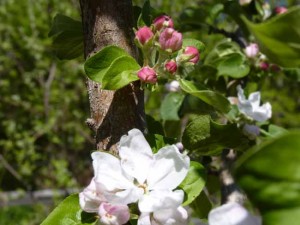Mid-Summer Waxing Honey Flow Moon
In to see Kate this morning after making some soup and killing potato pests by hand and soapy water. Integrated pest management suggests hands-on management for small crops. It’s actually pretty straight-forward to keep pests in check if you inspect regularly. Like the plastic bags for the apples. The concept also allows that some leaves will get eaten, some plants will get lost, but that if you plan for these and don’t excited, you can keep pesticide use to a minimum. I haven’t used any for years.
Companion plantings helps. Crop rotation helps. Regular surveillance helps. Replenishing soil nutrients helps. Every bit of positive input reduces the hold insects pests can get on your veggies.
Kate’s color looked normal this morning even though her hemoglobin is still a little low. She’s ready to come home. Her nurse yesterday tried to get her to wear little footies with a sticky pattern on the bottom. Kate doesn’t like things on her feet. “You don’t want to wear them even though it’s illegal?” I knew who would win this contest.
Back home for a nap, read a little, then got ready for Tai Chi. Kona had been injured in the morning, but I couldn’t find the problem. She held up her right front foot, which I checked carefully, finding nothing. Mark found the wound. It was a tear in her side just above the right shoulder.
Uh oh. This is the kind of stuff Kate makes easy. So. I called her and asked her if she could come home. Nope. Well, I figured. Her advice though helped a lot.
After a snappy, biting 10 minutes or so, I figured out how to do what needed to be done, Kona stood quietly and let me put a gauze pad on the wound and wrap it on with a sticky bandage.
I missed the first hour of Tai Chi, but I made it for my class. Be patient with yourself. Relax. Trust the process. Cheryl, the teacher, is a calming influence in a learning curve that can be difficult.
By the time I headed home I needed some comfort food. A peanut buster parfait later, I felt calmer myself.

 damage and as long as I can I’ll follow pinch and destroy. After that, I think, right now anyway, that I’ll go with Gary Reuter, the bee rangler for Marla Spivak. I’ll just put up with wormy apples. This is partly out of regard for the bees who have enough pressure of them and they don’t need an added pesticide load from our orchard, but it’s more out of a commitment to no pesticides, grow strong plants and let them fend for themselves. It’s worked reasonably well for me so far.
damage and as long as I can I’ll follow pinch and destroy. After that, I think, right now anyway, that I’ll go with Gary Reuter, the bee rangler for Marla Spivak. I’ll just put up with wormy apples. This is partly out of regard for the bees who have enough pressure of them and they don’t need an added pesticide load from our orchard, but it’s more out of a commitment to no pesticides, grow strong plants and let them fend for themselves. It’s worked reasonably well for me so far.